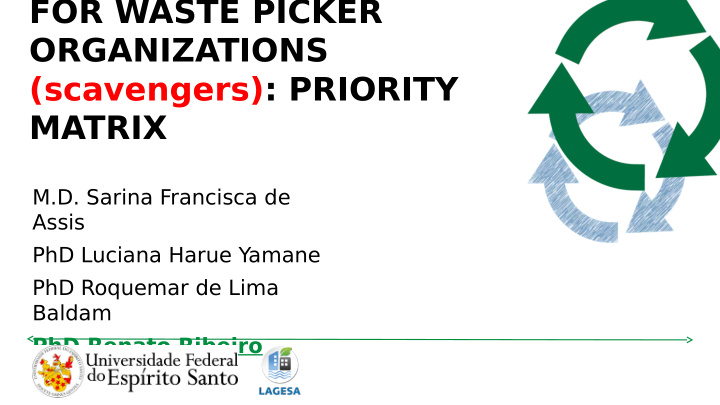



FOR WASTE PICKER ORGANIZATIONS (scavengers): PRIORITY MATRIX M.D. Sarina Francisca de Assis PhD Luciana Harue Yamane PhD Roquemar de Lima Baldam PhD Renato Ribeiro Siman
OPERATIONAL ACTIVITIES FOR WASTE PICKER ORGANIZATIONS (scavengers): PRIORITY MATRIX These organizations are present in about Collecting recyclables - These organizations are present in about 30 countries, covering mainly Latin 30 countries, covering mainly Latin scavengers: Common America, Asia and Africa (Global Alliance America, Asia and Africa (Global Alliance scenario Brazil before 2010 of Waste Pickers, 2015) of Waste Pickers, 2015)
OPERATIONAL ACTIVITIES FOR WASTE PICKER ORGANIZATIONS (scavengers): PRIORITY MATRIX These organizations are present in about Collecting recyclables - These organizations are present in about 30 countries, covering mainly Latin 30 countries, covering mainly Latin scavengers: Actual America, Asia and Africa (Global Alliance America, Asia and Africa (Global Alliance scenario Brazil of Waste Pickers, 2015) of Waste Pickers, 2015)
OPERATIONAL ACTIVITIES FOR WASTE PICKER ORGANIZATIONS (scavengers): PRIORITY MATRIX These organizations are present in about Collecting recyclables - These organizations are present in about 30 countries, covering mainly Latin 30 countries, covering mainly Latin scavengers: Actual America, Asia and Africa (Global Alliance America, Asia and Africa (Global Alliance scenario Brazil of Waste Pickers, 2015) of Waste Pickers, 2015)
FOR WASTE PICKER ORGANIZATIONS (scavengers): PRIORITY MATRIX Past Future Present
Introduction • With Brazilian Solid Waste Policy (Federal Law 12.305/2010), the Waste Picker Organizations (WPO) have been formally incorporated into Integrate Solid Waste Management • Among other obligations, It´s establishes that the cities must: • Eliminate the garbage dumps replacing them with landfjlls (which should receive only non-recyclable waste) • Improve your waste management process and implement selective collection systems, with the participation of WPO (promotion of social inclusion)
Introduction • Due their social and economic situation, the WPO have ineffjciently performed their Operating Activities of the Recycling Chain (OARC):
Introduction • The sustainability of WPO relies on their ability to carry out these activities with guarantee of institutional standardization, self-management, and the generation of work and income under adequate public health and safety conditions in order to achieve increasing social, economic, and environmental results; • The OARC of the WPO are non-standardized, disorganized, have rudimentary practices, and lack knowledge on the relationship between them and their respective importance; • The objective was to propose the hierarchical organization of OARC according to Criteria that Infmuence Market Effjciency (CIME).
Material and Methods Study area • The study was conducted in the state of Espírito Santo (ES)/Brazil, which has 65 WPO in operations.
Material and Methods Stages Methods Obtained results - Bibliographic and Stage 1 - Identify, select, documentary research CIME selected and - and prioritize CIME Exploratory survey with 80 prioritized Brazilian specialists Stage 2 - Check the - Documental research execution status of the Status of execution - Survey with 80 Brazilian OARC and classify its and classifjcation specialists execution (projects, of OACRs and scavengers process, or operation) - Focus Group in six regions of Espírito Santo with 124 Stage 3 - Consolidate the representatives of WPO and WPO collective judgment government OARCs priorities matrices to consider and - Multicriteria analysis prioritize their OARC - Analytical Hierarchy Process
Results and Discussion Stage 1 - Identify, select, and prioritize CIME of the CIME Weight WPO CIME 1 Ability to add value to the product 4.60 CIME 2 Support from the Government and development agencies 4.53 CIME 3 Being self-managed and organized 4.49 CIME 4 Ability to compete in the market 4.48 CIME 5 Ease of execution of production steps 4.43 CIME 6 Ability to receive and process USW 4.41 CIME 7 Representation and inclusion of WPO in the region 4.40 CIME 8 Client satisfaction 4.35 CIME 9 Compliance with legal requirements 3.83 CIME Quality of life 10 3.81 CIME Weights obtained in the evaluation of Criteria that Infmuence Market Assistance 11 3.56 Effjciency (CIME)
Results and Discussion Stage 1 - Identify, select, and prioritize CIME of the WPO 300 Ability to receiv e and proces s US WR P 251,8 250 238,5 Be ing self-m anaged a nd organiz ed 200 173,9 Eas e of ex ecution of production s teps 163,6 150 Support from the Gov ernment a nd development a gencies 97,0 100 75,2 Ability to compete in the m ark et 50 Ability to a dd v alue to the product 0 Eigen vector to Criteria that Infmuence Market Effjciency (CIME) of the WPO from Brazil
Results and Discussion Stage 2 - Check the execution status of the OARC and classify its execution (projects, process, or operation) • For the 74 OARC, 13% were classifjed as "fully performed", 49% as "partially performed", and 38% as "unperformed” • Regarding execution, 72% of them were classifjed as process execution, against 22% for project and 6% as operation
Results and Discussion Stage 3 - Consolidate the WPO collective judgment matrices to prioritize their OARC 0% 20% 40% 60% 80% 100% 120% Plan and align supply chain resources 100% Purchase raw materials 100% Plan and manage customer service operations 100% Establish governance and service delivery strategies 83% Understand markets, customers and organizational capabilities 83% Develop business strategy 83% Develop strategy of customer service and attention 67% Develop products and services 50% Manage strategic initiatives 33% Manage service delivery features 33%
Conclusions • The Criteria that Infmuence Market Effjciency "Ability to receive recyclable material", "Ability to receive and process USW", and "Being organized with self-management" stood out as the most important. • The operational activities of the recycling supply chain related to self-management and planning are those that the WPO have diffjculty achieving (since they were related for partially or unrealized activities). • Function: low knowledge about circular economy culture, non-adherence to the system of associativism/cooperativism, lack of specialized technical assistance, low level of schooling, frequent turnover, and lack of attendance and union by members of the WPO . • The OARC of "Planning and aligning supply chain resources",
Professor Renato Ribeiro Siman Federal University of Espírito Santo, Brazil E-mail: renato.siman@ufes.br Website: http://www.lagesa.ufes.br
Recommend
More recommend